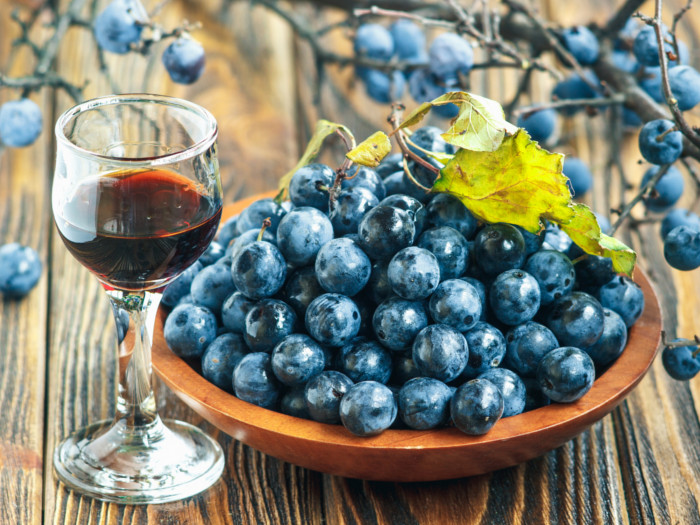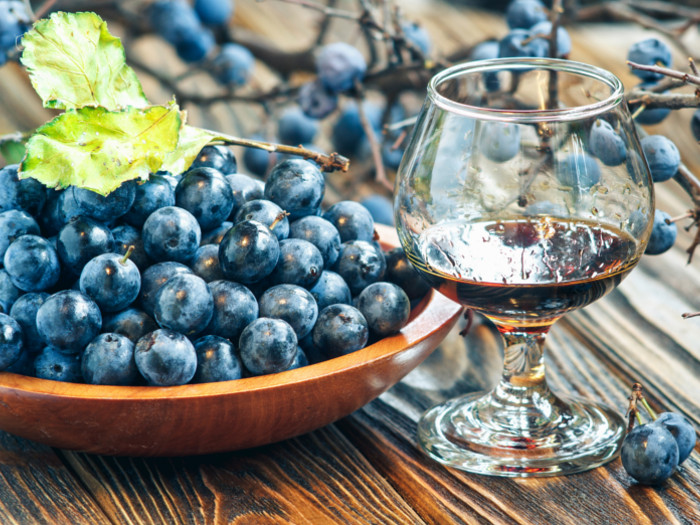Sloe gin is not the first bottle you may reach for in the liquor aisle, but it presents a unique production process. Sloe berries from the blackthorn tree are steeped in gin to make this traditional winter liqueur in the UK.
What is Sloe Gin?
Sloe gin is a British liqueur, made by soaking sloe berries in gin. This process produces a tart, almond-flavored gin. In the EU, this specialty gin is required to be at least 25 percent ABV, but in homemade recipes, the ABV can vary from 15-30 percent. Once the bottle of sloe gin is opened and strained of any fruit matter, the liqueur will keep indefinitely. [1]
Serving Size : Nutrient Value Carbohydrate, by difference [g] 2.23 Energy 66 Alcohol, ethyl [g] 8.3 Water [g] 89.36 Sugars, total including NLEA [g] 1.95 Calcium, Ca [mg] 4 Iron, Fe [mg] 0.02 Magnesium, Mg [mg] 1 Phosphorus, P [mg] 2 Potassium, K [mg] 9 Sodium, Na [mg] 16 Zinc, Zn [mg] 0.09 Copper, Cu [mg] 0.01 Vitamin E (alpha-tocopherol) [mg] 0.02 Cryptoxanthin, beta [µg] 3 Lutein + zeaxanthin [µg] 1 Vitamin C, total ascorbic acid [mg] 1 Thiamin [mg] 0 Riboflavin [mg] 0 Niacin [mg] 0.02 Vitamin B-6 [mg] 0 Folate, total [µg] 1 Choline, total [mg] 0.4 Folate, food [µg] 1 Folate, DFE [µg] 1 Fatty acids, total saturated [g] 0 16:0 [g] 0 18:2 [g] 0 Fatty acids, total polyunsaturated [g] 0 Sources include : USDA [2]
This type of gin was traditionally spiced with cinnamon and vanilla and sipped warm as a winter drink. It is often associated with Christmas and is making a sort of a comeback in recent years. However, when the liqueur was introduced in America in the early 20th century, it became popular as a summer drink and was usually served cold with tonic or mixed in cocktails. Since it is technically classified as gin, which is a distilled liquor, this variety should be gluten-free, but it is best to check by brand. [3]
Plum brandy is a popular substitute for sloe gin, along with apple brandy and various other fruit-based liqueurs.
Sloe Gin vs. Gin
- Origin: Gin is a clear distilled spirit, made with juniper berries. Slow gin is a liqueur that is flavored primarily with sloe berries, which have been soaked in the gin. [4]
- Alcohol content: Gin has a higher alcohol content than sloe gin. The alcohol content or ABV in gin generally ranges from 35-40 percent. [5]
- Taste: Gin is herbal flavored, often with floral notes, whereas sloe gin is traditionally tart, with light almond flavors.
You can visit What is Gin for more information.
How to Make?
It is easy to make this specialty gin at home. Let’s take a look.

Ingredients
- 500 grams of frozen slow berries
- 250 mg of caster sugar
- 750 ml of chosen brand of gin
Instructions
- To make sloe gin, start with 500 grams of frozen sloe berries.
- Prick each fruit to puncture it, then put the fruit in a 1.5-liter jar that can be sealed tightly.
- Add 250mg of caster sugar, and 750ml of your chosen brand of gin.
- Then, seal the mixture and place the bottle in a cool, dark place.
- In the first few days, shake the jar daily to help the sugar dissolve.
- Wait at least three months - but no more than six - to open the bottles, strain out the spent fruit, and then rebottle.
- Sloe gin can be sipped straight either warm or cold; both approaches are delicious!

Side Effects & Risks
Alcohol consumption, if done in an excessive manner, can lead to short-term health risks such as violence and injuries as well as long-term health risks such as addiction, alcohol abuse, and chronic diseases. According to the Centers for Disease Control and Prevention, people who should not drink alcohol include women who are pregnant, individuals younger than 21 years of age, and people who are recovering from alcoholism or cannot control the amount they drink. Also, it should be avoided by people who are planning to drive or any other activity that required focus, alertness, and skill. [6]
Different countries have different legal guidelines on alcohol consumption. According to The 2015-2020 Dietary Guidelines for Americans, if alcohol is consumed, it should be done in moderation. The guidelines define moderate drinking as up to 1 drink per day for women and up to 2 drinks per day for men, which applies to adults of legal drinking age. [7]

